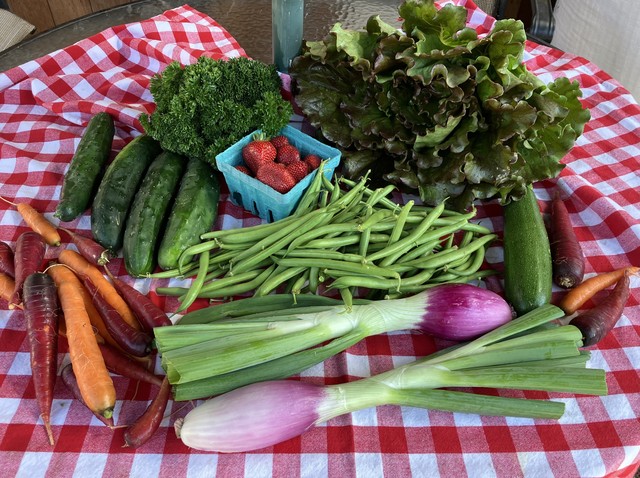- Green Beans
- Purple and Orange Carrots
- Cucumbers
- Curly Parsley
- Red Long of Tropea torpedo onions
- Strawberries
- Zucchini
On Rotation
- Lettuce
- Kale
Strawberries are back in the Harvest Basket after a two week hiatus! We've been pulling teeth trying to get enough berries out of the patch this year: yields have been two to three time lower than usual - in spite of giving the plants even more TLC than usual - and the bronzing episode we went through in July was demoralizingly long and widespread. Fortunately we've popped out the other side of the bronzing and the berries are back to being shiny, bright, and sweeter than ever these days. It also appears that we're having a little bump in production as of this week, so although we had to disappoint all of our wholesale accounts we were able to get the berries back into the CSA totes, harvest for the farmstand, and give a couple more beds over to the u-pick. Predicting the future on a farm is usually a terrible idea, prone to jinxing the whole outcome, but could it be that August/September might just be when our strawberry season finally hits its stride this year?
A depressed strawberry season has big economic ramifications for the farm, because even though the berries only occupy a humble half acre of space, they contribute disproportionately to the bottom line. Low yields make us ever-grateful for the abundance elsewhere on the farm, all of which helps make up for the strawberry income shortfall we're experiencing this year. But it also begs the question, what's going on out there in the berry patch to cause such a drastic reduction in yields? I've been casting about looking for answers this past month and from all the other farmers, gardeners and university strawberry experts I've spoken with, it appears to be a West-Coast-wide phenomenon. Even the mainstream commercial growers in California are having a rough year.
I got on the phone with Mark Bolda, a cooperative extension farm advisor with the University of California (and widely considered to be the THE guru when it comes to all thing strawberry), last week and he described a pretty grim season on the California coast. His theory is that our whopper of a winter - with so much prolonged rain - leached out too much nitrogen from the soil so the strawberry plants (which have a long and intense production season from June through September) are deficient in N and are firing on one cylinder instead of four. He said that among his growers on the Central Coast, those who increased their application of summertime Nitrogen are doing better than those who stuck to their standard fertility plan. It so happens that we've been feeding our plants twice the usual amount of organic fish emulsion since June (we run it through our drip irrigation lines every other week to stimulate the soil biology and support the plants). The problem is, there is a 6-7 week lag-time from application to ripe fruit (you get a flowering response from the strawberry plant two weeks after application, and then it's 4-5 weeks from flower to ripe fruit). So if we started doubling our rate of fish emulsion in mid-June and it's now early August, there's your 6-7 weeks. All to say, maybe we have reason to be hopeful that the berry patch is kicking into gear at last and will be more productive for the remainder of the season. Most of the plants look pretty healthy and vigorous - save for the zone that had to endure standing water for many weeks this winter during the worst of the weather - so I chose to be optimistic (it's kinda your only choice in farming, really....in fact, if there's one thing we farmers have in common, it's something that should be called "Perverse Optimism Disorder"). How else could we play this huge gamble each year?
Long story short, enjoy that little pint of strawberrie this week AND stay hopeful there will be more!

